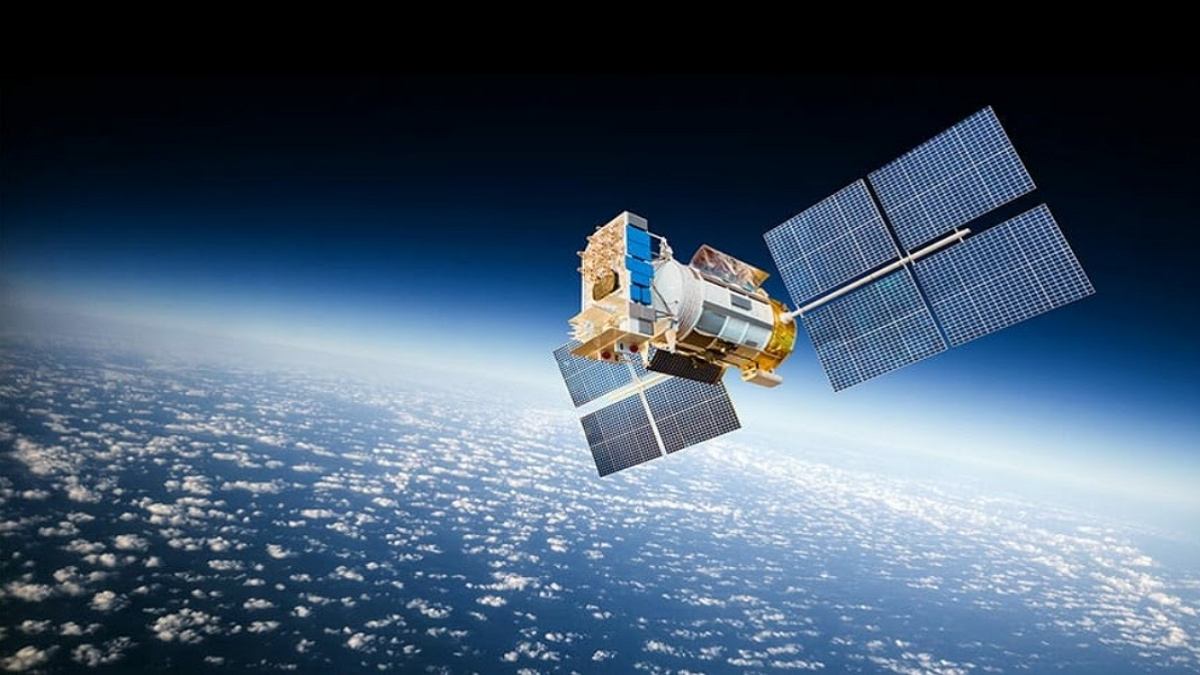While patrolling in the mountains, soldiers are constantly reminded not to lose height, because they also lose sight. My regiment is built on Shivaji’s tactics that teaches the Maratha warrior to remain mobile and occupy (rest on) high grounds. This gave Shivaji’s guerilla a distinct edge over the large Mughal forces because they could get better situational awareness and options to strike at the time and place of their choosing. Military profession teaches you the importance of ‘high ground’ and the ‘information’ as key factors of success. ‘Space’ is now seen as an essential and most significant domain of modern warfare.
The recent military clash at the Galwan Valley in eastern Ladakh and faceoff between PLA and the Indian Army has become a media marvel with satellite imageries from commercial grade transponders being displayed on the TV. Space is the ‘ultimate high ground’ that makes it possible for ordinary citizens to watch the world from God›s eye, even views from the battlefield. Those who occupy this high ground today would deny it to others tomorrow. Thankfully, India realised the importance of the space early. A British Brigadier once remarked to me in astonishment how a country like India could be running a poverty-alleviation programme and a space program concurrently. Subtly indicating our third world status yet with significant achievements in space, which was so far a preserve of the advanced world.
Globally, over 2,000 active satellites are orbiting the world today in various altitudes ranging from LEO (Low Earth Orbit) which is between 180-2,000 km of altitudes, MEO (Medium) from 2,000-35,780 km and GEO (High) above 35,780 km for geo satellites. Depending on their role, the satellites are either on Polar, Sun Synchronous, equatorial, elliptical or Geo-synchronous Orbits (GEO). Between the US and China, they own almost 60 percent of all satellites, with the US having close to 45 percent of global ownership. India’s share in the global pie currently stands at around 2.5 percent. Majority of the space slots over Indian space are occupied by the Chinese or US Satellites. The satellites are being put to use for Earth Observation, Communications, Navigation, Timing, Tracking and experimenting. The resolutions are constantly improving (below one metre) aimed for human spotting and identification. One-third of these satellites are known to have an active military role and with a large number of them in dual use. Space has become an essential part of modern warfare.

India is now headed towards being a space power with PM Narendra Modi literally triggering a space revolution by the introduction IN-SPACe, a new autonomous body with a policy that not only relieves ISRO from carrying the sole burden of India’s space sector but also unlocks the sector to private players that would catapult India to becoming a Credible Space Power. There are rapid technology upgrades in every field of space taking place in the world and catching up would not be easy unless such measures are taken. China has invested in QC-QT (Quantum Computing and Technology), which would harden most of their future satellites. ISRO needs to focus on closing this gap with private players as technology partners.
China launched its first satellite, a decade ahead of India in April 1970. Since then she is progressing rapidly and continues to showcase fast paced technological advancements in demonstrating space power. China landed its Chang’-4 spacecraft on the far side of the moon in January last year, becoming the only country to do so, with rover, Yatu-2 sending data from the reverse side of the moon and operating in temperatures well below -300 degrees Fahrenheit. China not only has demonstrated technology, but would be ahead in having access to rare materials from the moon. Having put two manned space labs in the Low Orbit, she is now putting another space station in three modules. China is reportedly developing a new telescope with a 300-times larger field of view than the American Hubble Space telescope.
As China continues to invest more into state-run space programs, it is also becoming one of the largest investors in private companies. She is rapidly developing both ISR and PNT satellites. The Beidou satellite system gives China independence from US’s GPS constellations for military and commercial activities. China plans to establish a global 24 hour, all weather earth remote sensing system and a global satellite navigation system. China is constantly upgrading China›s High Resolution Earth Observation System (CHEOS). She is experimenting with new capabilities after launching first-ever Quantum communications satellite in 2016.
Chinese have given outer space and cyberspace a high priority in the strategic competition, designating both as important domains of war fighting. In 2015 they raised the Strategic Support Force (SFF) to manage the military›s space, cyber, and electronic warfare missions. Strategists in PLA regard that “the ability to use space-based systems and deny them to adversaries as central to enabling modern warfare under the conditions of Informatisation”. PLA Rocket Force which manages the nuclear arsenal, has the jurisdiction over the Anti-Satellite (ASAT) capabilities. It is assessed that Chinese counter-space programmes are primarily designed to deter US strikes against China’s space assets and deny superiority to the United States and even attack US satellites.
Given the growing belligerence of China against India, the Chinese space edge is not only detrimental to India’s space programme but also poses a challenge to the world in case of a military confrontation.It is assessed that soon every satellite in any orbit will be at risk from the Chinese ASAT weapons. China is building co-orbital counter-space capabilities which serve dual-purpose of inspection and on-orbit servicing during peacetime and could attack adversarial satellites during war. Chinese military and technical papers often refer to ‘Directed Energy’ as an important part of counter-space technology. The recent activities demonstrate that China is proliferating its electronic and cyber capabilities in space. In 2018 alone, China tested most technologies in the counterspace categories.
North Korea’s space capabilities are closely tied to their ballistic missile development. There is no indication that North Korea has made a sustainable space industrial base, but its missile program is growing. Many believe that it is aided by technology from China and Pakistan. Little is known about North Korea’s operational concepts and space capabilities. North Korea has demonstrated only two counter-space technologies; electronic and cyber attack, the only significant risks of non-kinetic physical attack. North Korea’s believed highaltitude nuclear detonation capability, would indiscriminately affect all satellites in the target’s orbital regime.
Pakistan is investing incrementally in its Space and Upper Atmosphere Research Organisation (SUPARCO) with the budgetary allocation of approx $34 million to include Multi-Mission Satellite (PaKSat-MM1). It has established a Space Application Research Centre in Karachi with wings. It plans on sending a human to space, with the help of China by 2022. Pakistan has developed nuclear weapons and integrated them with ballistic missile systems. Its longestrange missile Shaheen 3, could potentially deliver a nuclear-capable warhead into LEO. Both North Korea and Pakistan are assessed to be leaning heavily on the space capability of China and the triad can bring in collusive capability against the world.
The Soviet space agency was the first in the world to place satellite Sputnik 1 into orbit in Oct 1957. They established the first contact with the surface of the moon through Luna 2 in September 1959, and also sent the first human into space (Yuri Gagarin) in April 1961. The first Indian Satellite Aryabhata was launched by USSR in April 1975, five years before India developed its indigenous launch vehicle. Even though Soviets were pioneers in space technology, the US surpassed them through funding of innovators embedded in the universities and private industry. Russia currently operates the world’s most robust human space programme. Russia was a founding partner of the International Space Station (ISS), despite souring relations, Russia and the US maintain strong partnership in space largely due to ISS.
Russia has revamped the existing Global Navigation Satellite System (GLONASS) through restructuring and upgrades. Over the next decade, Russia plans to revamp optical image satellites, land a scientific probe for Mars and a new human launch system. Russia has Kinetic ASAT and co-orbital counter-space programmes. Russia’s newest co-orbital system may be designed to target satellites in GEO. It is assessed to have capability to destroy and degrade satellites using non-kinetic physical counter-space systems. Russia is likely capable of destructive cyber-warfare targeting satellite systems and the ground systems that support them.
The US spends over $50 billion on space, which is 62% of the overall global spending of $80.7 billion. Of this, the US military spends $35 billion each year on space, which is twice NASA›s budget. The US military relies heavily on their private sector to deliver space solutions. Most government launches are carried out by SpaceX or the United Launch Alliance. SpaceX is planning to launch a global constellation of 4,425 satellites which will provide a total throughput of 23.70 Terabytes per second — a capability which will be leveraged by the US military. The rapid miniaturisation and cost reduction of the civil space sector in the US has been picked up by the US military. Project Blackjack under DARPA, for instance, envisages the use of multiple constellations launched and operated by the private sector to provide a resilient, persistent and reliable data network for troops and equipment on the ground.
The US private space sector has therefore led the way for the world in space technology, which has been mostly funded by the US government. Without government funding, such as NASA providing long-term ISS cargo resupply mission contracts to SpaceX and Boeing, these companies would never have reached the scale they possess today. It is the combination of Government grants for leading edge technologies such as free space optical communications or electric propulsion mechanisms, coupled with venture capital funding for new startups that have led to the US dominating space globally. The newly formed US Space Force is a beneficiary of the US’s current technological position in space, and will further focus R&D towards the military applications of space. The US has invested heavily on all the space domains for Military and civilian, which are largely dual use.
India has a well-developed missile development programme that has given an edge to India in space launch technology. India became the seventh country to launch its own satellite using the SLV-3 rocket in July 1980. Currently, India has two operational orbital Launch vehicles, with the Polar Satellite Launch Vehicle (PSLV) and the Geosynchronous Satellite Launch Vehicle (GSLV). With these two vehicles, India conducted seven launches in 2018, just a fraction of over 60 total launches. The PSLV has launched over 46 successful missions. It has also launched around 300 satellites of more than 30 countries. In February 2017, ISRO (PSLV-C37) launched 104 satellites belonging to different countries in a single rocket, which is a record. It launched Chandrayaan 2 in July 2019, which unfortunately developed a glitch on landing. ISRO is all set to launch Gaganyaan, a manned mission in the LEO later next year, albeit with a likely delay.
Indian Space Research Organisation (ISRO) is the official space agency of the Indian government with a vision to “harness space technology for national development while pursuing space science research and planetary exploration”. It is primarily meant for R&D in the space segment. It also controls the Department of Space, under the PMO. It has been also engaged in commercial activity and has a newly raised commercial wing NewSpace India Limited (NSIL). Recently, the PM has announced a major policy shift wherein the Indian private space sector that has a large pool of skilled and qualified scientists, largely qualified abroad, would now be available to work for India. Such startups can hugely contribute to advanced technologies to be infused into the space sector. This resource has been sitting on a limb, and waiting for an opportunity. With the change in policy, a large talent pool currently working abroad is likely to be drawn back into the country. The commercialisation of space is necessary to make India a space power, and also contribute significantly to India’s military capabilities, provided the policy framework eases business and incubates emerging technologies to participate. India’s private space companies are needed to bring in space-based services, which would greatly benefit India’s prevalence in the sector.
India has recently raised a Defence Space Agency that may subsume an existing Integrated Space Cell as Part of HQ Integrated Defence Staff. DRDO is actively engaged in supporting the sector through a dedicated Space Project. It is claimed that India does not want to weaponise the space or create harmful debris. The space now becoming a rapidly contested global common, space-faring nations are increasingly concerned about securing their space assets. It has however demonstrated its kinetic counter-space capability in March 2019 by shooting its own non-operational satellite in the Low Earth Orbit. India has several medium range and ICBMs that have the capability to deliver a credible payload into the orbit. Indian space is vulnerable to exploitation by the global orbital slots. India needs to invest in hardening the satellite technology to match the challenges posed by Quantum technologies. Space threat detection, Miniaturisation of assets and counter-space kinetic and non-kinetic assets are significant steps to keep Indian space secure. Increasingly, cyberspace and digital platforms are becoming space dependent and controlled. The industrial platforms and military machines are turning digital and would run on AI engines, making military 4.0 compatible with the Industry. The Indian Defence Expo 2020 was rightly based on a digital theme. As development in space and cyber domains grow, we are headed to C5I2STAR cluster that brings Command, Control, Communication, Computer and Cyber in single domain, as also brings Target Acquisition as part of the same cluster as the ISR.
The world space programmes are growing at a very rapid rate, and space is likely to get congested leaving no scope for the laggards to catch up. Space shall soon become a more exclusive club and those who cannot occupy the slots early are likely to face denial. Planetary exploration is another race. Those who establish presence on the Moon, Mars or other planets shall get early access to the rare materials. A possibility of establishing a permanent moon station cannot be ruled out in near future. Once heavy landing crafts are tested successfully, cargo flights for shipping rare materials may turn out to be one of the most lucrative and exclusive business domains adding a new dimension to the space economy.
India needs to strategically synergise with incubating technologies through the commercial domain such as startups into the ecosystem to overcome these emerging challenges.
Disclaimer: Views are personal; information extracted from open sources.
Courtesy: CSIS, Space Threat Assessment Report 2019.
Lt Gen P.J.S. Pannu was commissioned into 22nd Battalion, The Maratha Light Infantry (MLI) on December 13, 1980, and commanded the battalion from May 1999 to February 2001 in Uri Sector (Jammu and Kashmir) during Operation VIJAY. He commanded an Infantry Brigade in Kashmir Valley and an infantry division in the North-East. He was GOC 14 Corps and later retired as Deputy Chief of Army Staff. Lt Gen Pannu conducted the first ever space exercise IndspaceX in 2019.







